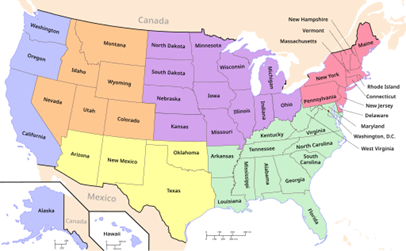
A] Prelude
For more information on pension systems, risk and coverage, feel free to visit our dedicated webpages:
https://expatpensionholland.nl/usa-expat-pensions
https://expatpensionholland.nl/global-pillars-systems
https://expatpensionholland.nl/global-investments-risks-0
https://expatpensionholland.nl/global-social-security-coverage
For even more information feel free to visit the following external sites:
https://www.bankrate.com/retirement/best-and-worst-states-for-retirement/
https://www.kiplinger.com/retirement/happy-retirement/best-places-to-retire-in-the-us
https://www.eurofound.europa.eu/en/blog/2023/europes-widening-rural-urban-divide-may-make-space-far-right
B] The Issue
Geography is destiny, the saying goes, but money redraws the map. It’s certainly true with the U.S. economy, where the bulk of GDP is generated in urban, coastal areas. It’s also true, says a new study, for just how financially well off our retirement may be.
This shouldn’t come as a surprise. Urban areas, says a recent Brookings Institution study, outperform rural ones in metrics like GDP per capita, job creation and wage growth; it stands to reason then that benefits, including those for retirement, would be better as well.
C] The Urban-Rural Gap
The urban-rural gap is wide. A study by the Economic Innovation Group, a Washington-based bipartisan nonprofit public-policy organization, reveals that when it comes to retirement, rural workers are at a significant disadvantage to their urban counterparts:
- Half of rural adults working full time in the private sector don’t have access to a workplace retirement plan!
- On average, rural workers hold approximately half the retirement savings of their urban counterparts, resulting in a gap of nearly $ 55,000!
- Living in a rural area reduces the likelihood of having a retirement plan by 13 percentage points, even when accounting for income, education, industry and other factors.
- Low-income workers fare worse everywhere when it comes to retirement savings, but rural low-wage workers are disproportionately disadvantaged.
D] Why the Gap?
The reasons are well-known and mutually reinforcing. The bulk of America’s wealth is produced on the urbanized East and West coasts, where there’s a concentration of fast-growing, “modern” industries (finance, high tech, media, healthcare, etc). These urban areas tend to have better infrastructure, logistics, access to capital and world-class universities.
So it’s hardly surprising that these “innovation clusters” attract better educated, entrepreneurial strivers. Many are — and I’ll introduce a new phrase — “domestic immigrants” who leave rural areas for these faster-growing, more lucrative urban ones.
“Rural workers typically have lower incomes and education levels than their urban counterparts, and work for smaller firms,” says EIG research associate Sarah Eckhardt. “We found that these factors are correlated with the likelihood that a person has access to a retirement plan, and explain some of the rural-urban disparity. However, even when factoring out these differences, rural workers are still 13 percentage points less likely to have access to a retirement plan, which reveals a significant urban-rural gap.”
E] 401(K) Cost Perception
We have mentioned the smaller-company disadvantage before. Setup and management fees for retirement plans like 401(k)s are rather modest for big companies, but can be a disproportionate burden for smaller ones. This helps explain 2023 findings from the Bureau of Labor Statistics’ National Compensation Survey, which said that over 90% of companies with 500 or more employees offer a retirement plan to workers, while about half of businesses with 50 or fewer employees do.
F] How To Fix IT: Auto-Enrollment & Portability
Federal lawmakers and some states are trying to fix this. The Senate and House are working on similar versions of the Retirement Savings for Americans Act (RSAA), a federally-administered retirement savings program designed to assist workers without access to employer-sponsored retirement plans.
Both versions of the legislation propose to automatically enroll workers into plans, while providing matching contributions for low- and moderate-income employees. Both bills would also be portable, meaning if a worker changes jobs they could take the plan with them. But don’t hold your breath waiting: Neither bill — both were introduced in the last Congress in 2023 — has gained much traction
An analysis shows that most Roth IRAs — meaning that retirement withdrawals are not federally taxed — come with no cost or fiduciary responsibility to the employer, and are portable, moving with an employee to their next job. Many also allow employees to sign up for a traditional IRA for pretax contributions if that’s what they’d prefer.
G] Finally
Meanwhile, we’ll add something else that’s detrimental to the long-term finances of rural Americans. Unlike big urban areas, where there seems to be a bank on every corner, large corridors of the nation are banking deserts. Fed Communities — part of the 12 reserve banks of the U.S. Federal Reserve — notes that while online banking is growing, “physical banking still plays an important role for many consumers. Lack of access to banking services can mean losing opportunities to improve financial health and build wealth.”
No rap against online banking, but a brick-and-mortar bank offers citizens the opportunity to sit down and discuss their financial situation and goals with a bank representative. Such encounters can lead to the opening of savings accounts, retirement accounts and better long-term outcomes. That’s not just good for workers, their families and their retirement, that’s good for the country itself.
Finally it be mentioned that the urban-rural retirement gap is not only an issue in the U.S. but also on other continents like for example the EU.
